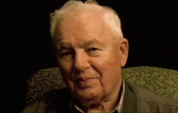1:39 | Having served aboard the USS Callaway in the Pacific, Ted Dunbar recalls how dead bodies were temporarily held on the ship.

Ted Dunbar describes the uncomfortable conditions and his duties serving in the boiler room on the USS Callaway.